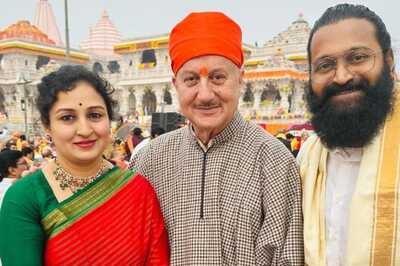
views
In the last few weeks, we have all become witnesses and participants to two important debates, one deeply intellectual and the other more visceral in nature. Both go back and forth on the question of what it means to be a Muslim in India today.
The first was triggered by Harsh Mander. In his piece for The Indian Express, he talked about the growing marginalisation of Muslims in Indian society. The very sight of skullcaps and burqas, argued Mander, was enough to polarise Hindu votes.
Mander was trying to focus our attention towards the decline in the number of Muslim candidates fighting elections. Clearly, very few tickets are now being given to Muslims by parties, including those who boast of their ‘secular’ credentials.
Not only are Muslims asked to attend political rallies without their burqas and skullcaps, as Mander pointed out in his column, Muslims are also being instructed not to turn up to voting booths during early hours of voting — to not scare away Hindu voters.
But does this political xenophobia surprise us? It shouldn’t, considering how years of communal folklore, public rumours and social prejudices, all serving a militant Hindutva agenda, have been fed to us over and over again.
The dark green colour, Urdu, biryani, jewellery, monuments — from items of daily use to icons of our society, there were certain items that were branded 'Muslim' or 'Islamic' by nature and therefore forbidden.
This brings us to the second debate, which was provoked when someone boasted on Twitter about cancelling a cab because his would-be driver was a Muslim. His very name was enough to jeopardise the livelihood of the cab driver.
To be sure, we haven’t abruptly come to this. Communal fires were ignited in our minds since our very childhoods and some of those fires have simmered on quietly since.
Let me share with you a short parable that was fed to me at a very young, impressionable age.
This was way back in 1971. I was not a voter then, so young that I didn’t even know that burqas and skull caps were worn only by people of a particular faith.
One day, with other students of my school, I was taken to nearby Railway Maidan to join a procession. We students were shouting slogans against then Pakistan president Yahya Khan. One of the slogans was “Yahya Khan ki teen dawai, lattam juttam aur pitai (Yahya Khan’s three remedies —kicks, punches and thrashing)”.
We went on to burn the effigy of Yahya Khan, hailed the creation of Bangladesh, dividing Pakistan, and heard the heroic tales of Indian soldiers during Indo–Pak war.
One of these stories was very interesting. Muslims are spiders and Hindus are chameleons, we were told. To prove this point, an anecdote from Indo–Pak war was narrated to us.
The ‘Hindustani’ army (our army wasn’t referred to as the Indian army) was chasing the Pakistani army in Bangladesh. Pakistani soldiers while retreating suddenly vanished. Hindustani soldiers were taken aback by this sudden disappearance of their enemies.
What had actually happened was that Pakistani soldiers had jumped into a ditch and a spider there weaved a web over them, thereby making them invisible to the Hindustani forces.
When Hindustani soldiers reached the ditch, all they could spot below were some spider webs.
But just then a chameleon, also sitting in the ditch, came to the aid of the Hindustani forces and pointed out their enemy to them by shaking its head towards the spider webs. Having understood their game, Hindustani forces unveiled Pakistani soldiers, dragged them out of the ditch and killed them.
This parable of the spider and the chameleon sowed a divisive seed of hatred in our minds at a tender age.
We started killing spiders at every possible opportunity.
During our adolescence, we were asked to be extra cautious during Eid. A general complaint that was shared with us was that water and power supplies were extended to Muslim colonies during Eid. We were made to see the number of ‘Pakistani’ colonies around us. “Never venture around those Pakistani colonies,” we were told.
We are being forced to find those “Pakistani colonies” again and retreat to colonies of our co-religionists. Not for nothing was Congress president Rahul Gandhi forced to declare during the recent election campaign in Gujarat that he was a “Janeyudhaari (sacred-thread wearing) Hindu”.
Language has also been put to such purposes. A recent election slogan called opposition parties ‘Kasab’, a Hindi abbreviation for Congress, Samajwadi Party and Bahujan Samaj Party.
Ajmal Kasab still remains in public memory as one of the Pakistani terrorists who, after having killed several people during 26/11 Mumbai attacks, spent the rest of his time till his execution munching biryani (that the person who floated this lie later confirmed it to be such didn’t of course change the popular view).
The simple fact of the growing communalisation of our shared culture iconography is this — threats make minority community defensive and insecurity among majority community makes it aggressive. And this very aggression completes the phenomena of militarisation of majority community at the end.
You cannot resist the temptation of killing that spider.
(The author is a senior journalist. Views are personal.)



















Comments
0 comment